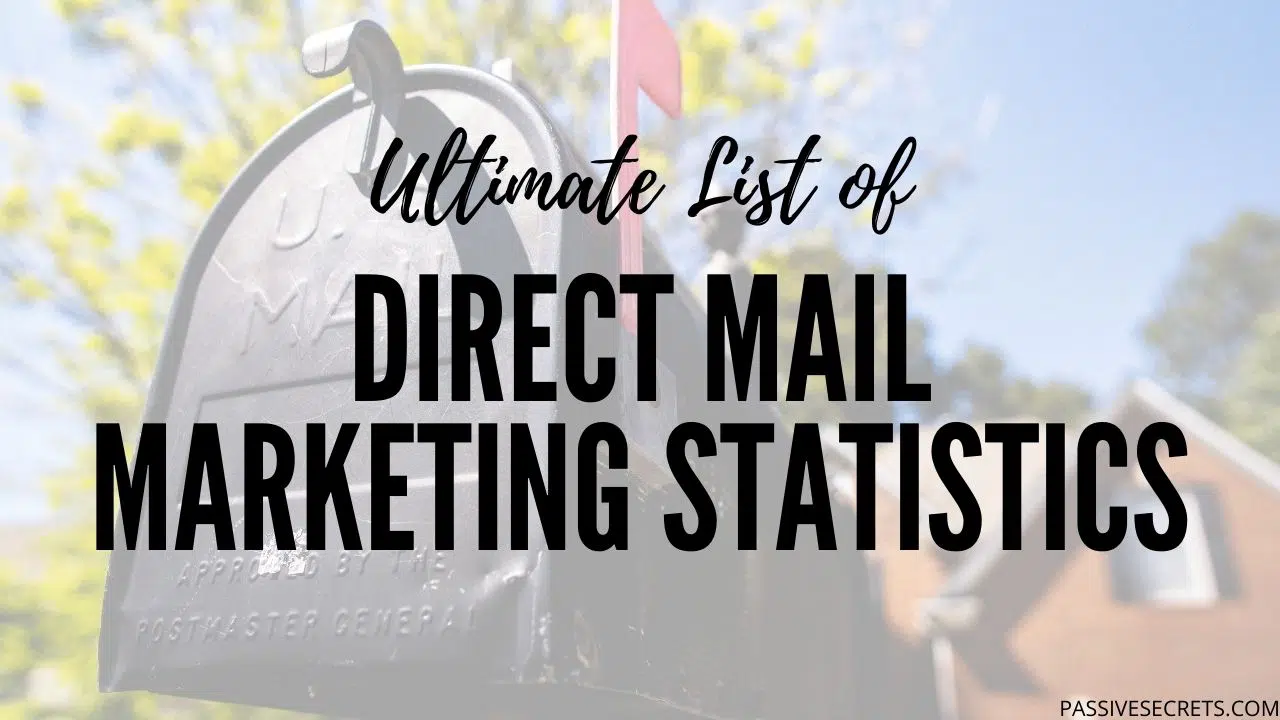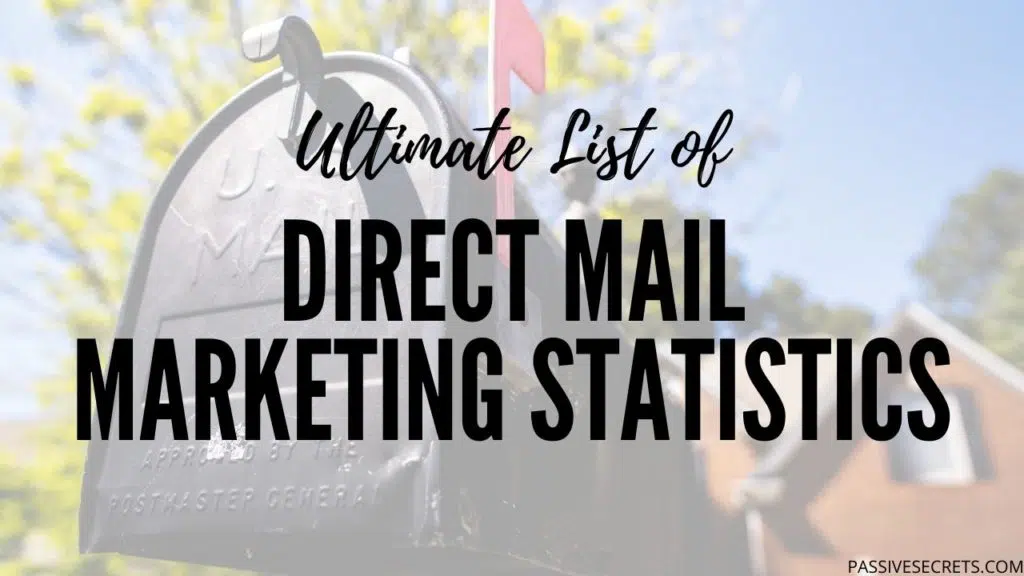
The world of advertising has indeed become more digital. However, some offline/traditional marketing strategies are still very effective today. One of them is Direct Mail Marketing.
Contrary to what most marketers think, direct mail marketing is an excellent lead-generation strategy.
Direct mail marketing is often overlooked in business marketing plans. It’s crucial to leverage both online and offline strategies for optimal results.
Omnichannel marketing statistics have shown us that integrating online and offline marketing channels can boost your sales results. Hence, direct mail marketing can be used alongside email marketing as a means of integrating online and offline marketing.
In this article, you will learn about the performance of direct mail marketing. Aside from direct mail statistics, this article contains trends and strategies to boost your direct mail marketing plan.
What is Direct Mail Marketing?
Direct mail marketing involves sending physical marketing materials, such as postcards, letters, and brochures, to a targeted audience through the mail.
This form of advertising has been around for a long time and has proven to be a successful way to reach customers.
Direct mail marketing allows businesses to target specific demographics and create customized messaging to appeal to their interests.
While the rise of digital marketing has led some to believe that direct mail marketing is no longer relevant, this is far from the truth.
In fact, direct mail marketing has become more targeted and personalized than ever before, making it a valuable addition to any marketing strategy.
All your direct mailers need is something that identifies you or your company, a call to action (CTA), and a mechanism for your clients to reach you.
The rest is all up to you. You can be as creative—or as simple—as you like.
Direct Mail Vs. Email
The major difference between direct mail and email is that direct mail sends physical (tangible) sales materials, but email doesn’t.
Email means “Electronic mail,” which means that whatever you receive via email is digital (intangible).
Although direct mail marketing can be described as old-fashioned, consumers (especially millennials) prefer direct mail to emails because it feels more personal.
Also, emails are often getting ignored these days. They only have a lifespan of just 2 seconds before they are deleted or ignored.
Most marketers also prefer direct mail because they can still send ad mail, whether the recipient subscribed or not.
Also, direct mails are preferable because your mails don’t have to get directed to the spam section.
A majority of emails in the spam section never get opened. After 30 days, the emails are deleted. This means your efforts are put in vain.
However, you can simultaneously use both direct mail marketing and email marketing to strengthen your marketing strategy.
For example, you can send emails to your customers informing them about a promo sale. Then, you follow them up with a direct mail as a reminder to participate in the sale.
Trending Direct Mail Statistics
1. In Q1 2023, over 6.3 billion direct mail pieces have been sent out by marketers and companies. (source)
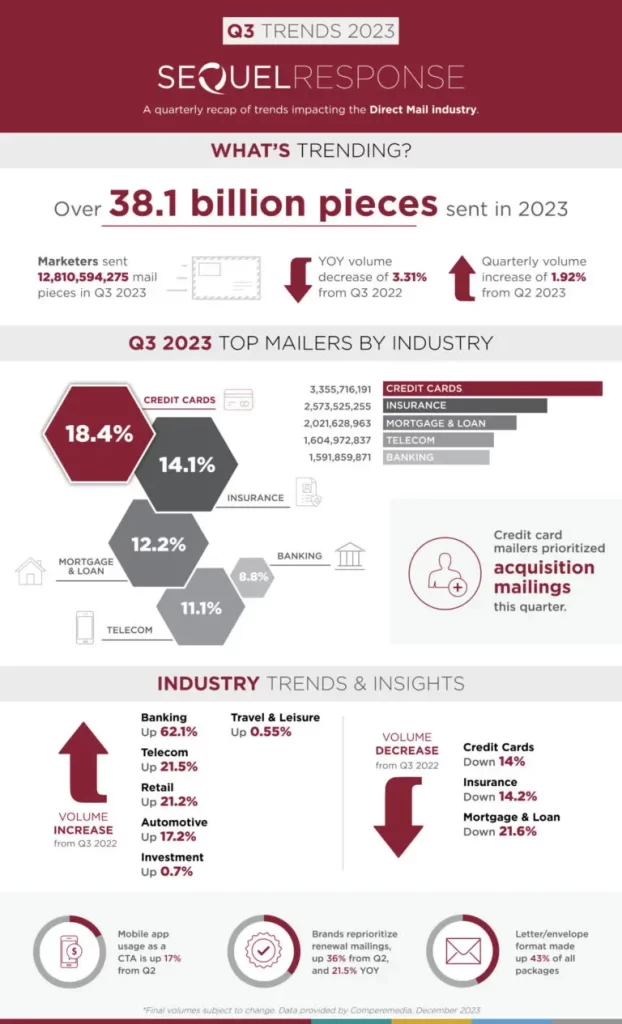
2. The global direct mail advertising market is expected to grow at a CAGR of 2.4% and worth $84.72 billion by 2027. The market is expected to increase from $74.65 billion in 2022 to $76.95 billion in 2023. (source)
3. The total direct mail advertising revenue generated worldwide in 2021 was $71.6 billion. The figure hit 72.7 billion in 2022. In the U.S., the generated revenue was $14.47 billion. (source)
4. However, in 2023, the direct main advertising revenue was estimated at $76.95 billion. (source)
5. In 2022, the U.S. direct mail volume amounted to 72.3 million. This is less than the volume in 2019, which amounted to 81.41 million, right before the pandemic. (source)
6. By 2024, the direct mail advertising industry revenue is projected to amount to $10.1 billion. (source)
7. The top direct mail company in the world is PR Donnelley. It holds 1.25% of the global direct mail market. PR Donnelley is a Communications company in Chicago. It is also a Fortune 500 company. Quads/Graphics comes second, with 1.12% of the global direct mail market share. It is a commercial printing company offering marketing strategy and management services. (source)
8. On average, consumers spend up to 30 minutes reading their mail. Customers easily trivialize emails and if your goal is to not be discarded, direct mail is a much better option. Give your audience something to remember, and you will be taken seriously. (source)
9. 77% of Americans can’t wait to see what mail they have received. They sort through their mails immediately. Most Millennials, Baby Boomers, and even Gen Xers require a physical copy of the information (e.g., a postcard or flier) for credibility’s sake. (source)
It has further been proven that direct mail has a higher response rate than any other form of advertising, which makes it more than simply meeting your audience’s preference. This way, you get to kill two birds with one stone — satisfy your customers and increase sales for your business.
10. 70% of consumers admit that direct mails are more personal than online interactions with brands. (source)
One advantage of direct mail over other forms of advertising is how it can be customized to each customer. You can use the modern advantage of technology to get personal information about customers that can be incorporated into each mail sent to them.
11. 67% of respondents from the USPS report on direct mail agree that mails feel more personal than the internet. Personalized mail is more than just inserting the individual’s name on the front cover of the postcard. You would have to go in-depth about how your design, content, and delivery. (source)
12. 26% of over 2,000 interviewed consumers say that direct mail ads help them make the smartest purchase decisions. Direct mail does not require much cognitive thinking on the part of the customers. Hence, decisions can be made without the usual struggle of indecisiveness. (source)
13. Direct mail influences up to 42% of purchases in “high-consideration” categories. With direct mail, there is a higher chance that you get some sort of response from your audience. One way to make sure is by including clear CTAs. (source)
14. Up to 80% of millennials are attentive to direct mail. (source)
15. 88% of important financial, insurance, and auto-related decisions (cars) are discussed at home. Direct mails give recipients a reason to discuss the offer. (source)
Since people are skeptical about making final decisions in public, direct mails help you take those decisions to them. This makes sales easier because customers will be comfortable enough to make certain commitments or purchases.
16. The average household in the U.S. received up to 455 direct mails, in 2021 — 361 for marketing direct mails and 94 for non-profit direct mails. (source)
17. About 68% of household consumers toss out direct mails they receive from companies they do not know, especially if they are not interested in the category. However, 76% will respond to a direct mail from a company they have purchased from before. (source)
18. 82% of important retail purchases involve the home. Decisions to make these purchases are made at home. Direct mailing influences these decisions, especially if these emails address their needs. (source)
19. Using catalogs in your direct mail leads to about $3–$9 in return for every $1 spent. (source)
A catalog is simply a listing of the products up for sale and every detail (price, descriptions, color, reviews, etc.) that your audience needs to know. Including a product catalog in your direct mail helps to convey enough information about your product and it reduces back and forth.
20. Up to 78% of surveyed business professionals say they find personalized direct mails to be effective for reaching their target audience. However, 61% say non-branded or non-personalized direct mails are effective. (source)
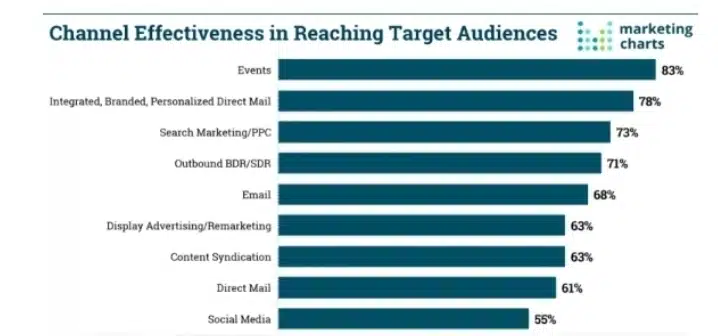
21. Postcards (53%) and letters (52%) remain the most popular forms of direct mail campaigns for marketers. Postcards and letters are very effective ways of sending direct mail to customers. (source)
Postcards are concise messages that provide apt knowledge about your brand, while a letter is more. detailed piece of information contained in an envelope.
22. Two-thirds of over 150 companies interviewed say that direct mail marketing shows the best ROI compared to the other current marketing channels. ROI is proof that lets you know if a particular marketing strategy is working for your business. (source)
Direct mail marketing may or may not reach a wide audience. However, its biggest advantage is that it has a higher response rate, which gives a higher ROI than any other marketing strategy.
23. 80% of surveyed businesses say they send some sort of personalized direct mails. (source)
24. Companies that use technology to automate their direct mail campaigns experience higher Return On Ad Spend (ROAS) than their competitors. (source)
25. 51% of marketers use software to execute their direct mail campaigns. 42% use in-house teams to design and write their campaigns, while 33% of marketers/companies use an agency to design and execute their campaigns. (source)
26. Direct mail has a 20% more motivation response than digital advertising. This means that direct mail is far more persuasive than using only digital ads. (source)
27. Targeting customers one-on-one increases your direct mail ad’s response rates by 50%. (source)
28. The average response rate for direct mail is between 2.7% to 4.4%. This response rate is higher than that of emails, measured at 0.6%. (source)
A direct mail response rate refers to how recipients engage with your mail campaigns. The direct mail statistics show that this offline marketing strategy can increase your response and conversion rates. This is mainly because households tend to keep physical mails longer than emails.
29. Up to 60% of customers agree that receiving direct mail leaves a long-lasting impression and helps them recall the advertising in the future. (source)
30. For B2B businesses, the average direct mail response rates for prospect lists and house lists are 4.9% and 9%, respectively. (source)
Your prospect list consists of potential customers who fit your target audience persona. They are more likely to purchase from you because they may need what you offer. Direct mail marketing is most effective when you send to potential customers who need what you sell.
However, your house lists consist of your existing customers. They have either ordered from you at one point in time, or they are still ordering.
31. The average direct mail response rates for non-profit organizations range from 5% to 9%. However, when such organizations combine their direct mail campaigns with digital methods, their response rates will increase to 28%. (source).
32. In 2023, 58% of marketers allocated more of their marketing budgets to direct mail compared to 2022. (source)
33. Regarding Direct-to-Consumer (D2C) brands, 63% of marketers invest in direct mail marketing strategies. (source)
Direct mail marketing is more expensive than email marketing or social media marketing because of the costs of designing the advertising materials, amongst other factors. However, it is a promising investment for your business.
34. Most B2B marketers allocate 18% of their marketing budget to print advertising and direct mail marketing. (source)
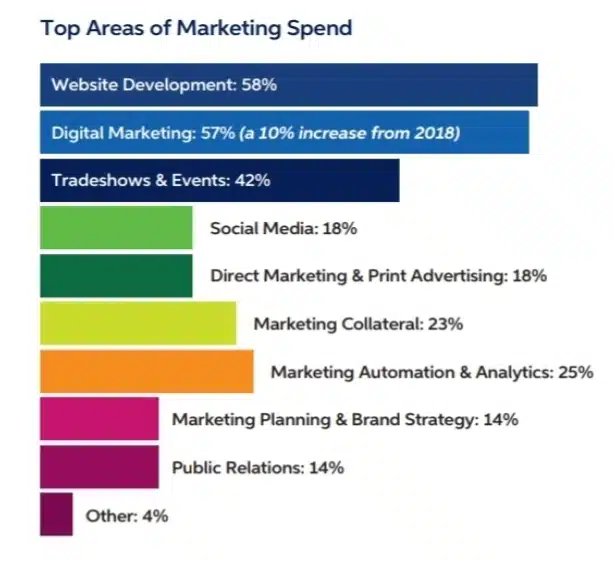
35. The revenue generated in 2021 by direct mail advertising providers in the U.S. amounted to $9.95 billion. This was an increase from the previous year’s amount, which was valued at $9.47 billion. (source)
36. The U.S.’s market spending for direct mail marketing was expected to rise to $43.3 billion by the end of 2022. (source)
37. In 2021, the revenue for postal services in the U.S. increased to $14.5 billion. This figure is equivalent to a 4.9% increase from the previous year. (source)
38. In 2021, the United States Postal Services (USPS) delivered over 66 billion ad mails. (source)
39. The ROI for direct mail in the U.S. is 112%. This makes it the marketing channel with the highest return on investment. SMS followed in second place with 102%. Emails are left with 93% ROI. (source)
40. 76% of retail marketers and 64% of travel marketers identified “Purchase” as their primary goal when sending out direct mails. (source)
41. 29% of business marketers use direct mail to promote products/services to already-existing customers. In the same survey, 27% say they use direct mails to acquire new customers. (source)
42. As of 2023, 74% of marketers agree that direct mail gives more ROI than any other marketing channel. This is more than the 67% of marketers who agreed to the same in 2022. (source)
43. In 2021, the direct mail ad spend in Japan amounted to 344.6 billion Japanese yen. This is equivalent to $2.48 billion. (source)
44. 36% of marketers cite poor response rates as their biggest direct mail challenge. 32% said bad address data for their customers is their biggest challenge. 26% say theirs is budget constraints. (source)
Direct Mail Statistics for Millennials
45. 59% of millennials find direct mail more useful than emails. They prefer the information received from mails to that of emails. (source)
Millennials are the generation that engages with direct mail the most. It is mostly because millennials feel more comfortable responding to a marketing channel they have been familiar with for many years.
46. Millennials (Gen Y) are the most excited generation to receive direct mails, with 65% saying they love receiving direct mails. For the Gen Z generation, about 57% say they are excited to receive such mails. (source)
47. 88% of millennials take their time to look through their mail, and 80% look forward to seeing the information in their mails. (source)
Most millennials prefer direct mails because of how personalized it is. Using nice graphics, colorful backgrounds, and detailed yet straight-to-the-point information would help you stand out and leave a good impression in the minds of your audience.
48. About 62% of millennials would rather read through the information in the advertising mail than discard it without opening it. (source)
49. 68% of millennials read print ads from retailers. These print ads also include coupons and promotional ads. (source)
50. 72% of millennial parents agree that direct mail (and other print ads) influence them to purchase from the retailer. (source)
51. About 65% of millennials pay attention to direct mail ads. (source)
52. 58% of millennials say they don’t need to worry much about direct mail privacy compared to digital communications. (source)
53. Millennials review each mail to ensure they don’t dispose of any valuable information. As a result, physical ads (including direct mail) leave a lasting impression on millennials compared to digital ads. (source)
54. The major reason why people check their mail is to see if they received any important items like legal documents, bills, etc. (source)
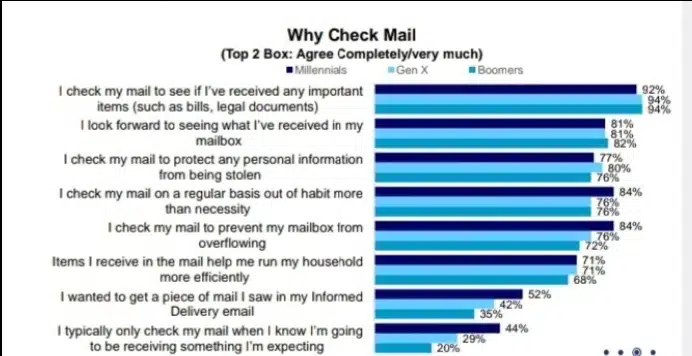
55. 47% of surveyed Millennials say they visit a company’s website after receiving direct mail from them. Another 36% say they share the information from the direct mail with someone else. (source)
Direct Mail Marketing Trends For 2024
As technology advances, it’s easy to assume that direct mail marketing will become a thing of the past. However, this couldn’t be further from the truth.
In fact, many businesses still rely on direct mail to connect with their target audience. As we look ahead to 2024, there are several direct mail marketing trends that you should keep in mind.
1. Personalization
Personalization has become a buzzword in marketing in recent years, and for good reason. Personalized marketing messages are more effective than generic messages because they speak directly to the recipient’s interests and needs.
In direct mail marketing, personalization can be achieved through a variety of methods, such as using the recipient’s name in the message or tailoring the message to their specific interests.
One effective way to personalize direct mail pieces is through variable data printing.
This technology allows different versions of a mail piece to be printed with different text, images, and other elements based on your target audience demographics and interests.
This makes each piece unique and tailored to the individual recipient, increasing the chances that they will engage with the piece and take action.
2. The Rise of Tactile and Sensory Marketing
In a world where we are bombarded with digital messages and advertisements, tactile and sensory marketing can be a refreshing change of pace.
Tactile marketing involves using physical materials, such as textured paper or embossed designs, to create a memorable and engaging mail piece.
On the other hand, sensory marketing involves engaging multiple senses, such as smell or sound, to create a more immersive experience.
Both of these techniques can be highly effective in direct mail marketing because they create a lasting impression on the recipient.
By engaging multiple senses, tactile and sensory marketing can create a more emotional connection with the recipient, making them more likely to remember the message and take action.
3. Incorporating Social Media into Direct Mail Marketing Campaigns (Omnichannel)
By integrating direct mail with other marketing channels, such as email, social media, and SMS messaging, businesses can create a cohesive and effective marketing campaign that reaches consumers through multiple touchpoints.
Omnichannel marketing statistics show that businesses are now using different marketing channels to reach their audience and integrate them seamlessly.
This type of marketing improves the user experience.
Customers can interact with your business from one channel and continue exactly from where they left off in another channel.
When it comes to direct mail marketing, social media is a complementary marketing channel you should use.
One effective way to incorporate social media into direct mail marketing is by including social media handles or hashtags on the mail piece. This encourages the recipient to engage with the business on social media and can help to build a relationship with them over time.
4. Digital Integration
There are numerous ways to connect printed direct mail to digital marketing channels. QR codes and pURLs are the most basic ways in use today, although other connections are available.
You can check for options such as online cart abandonment mailings, social media linkages, and anonymous web visitor direct mail.
The infrastructure for a more complex connection between physical mail and digital platforms is already in place.
Sometimes, the integration begins with the direct mail item and continues digitally. While other times, the communication begins digitally with direct mail used for reinforcement and follow-up.
You can also use data analytics to measure the effectiveness of your direct mail campaigns and make necessary adjustments.
5. Data-Driven Targeting
Digital printing and smart document composition software make it simple to narrow down a list and market to a specific group of prospective clients.
Marketers can utilize data on purchasing history, internet behavior, and demographics to target the best prospects and remove likely non-responders from their mailing list.
Artificial intelligence will play a larger part in mailing list filtering by spotting trends and evaluating prospects depending on how well they match a buyer profile.
6. Sustainable Mailpiece Design
As consumers become more environmentally conscious, they expect businesses to make sustainable choices.
Using eco-friendly materials and printing techniques can help businesses reduce their carbon footprint and appeal to consumers who prioritize sustainability. For example:
- Attempting to use recyclable paper for the mailpiece.
- Using paper made from pulp from ethically managed, FSC®-certified forests.
- Using thinner, lighter paper reduces the amount of raw resources needed.
- Using environmentally safe printing techniques.
- For example:
- Designing the mailpiece with easy recycling in mind.
FAQs on Direct Mail Marketing
1. What Are The Key Benefits Of Using Direct Mail Marketing?
Although it’s not widely popular, direct mail advertising benefits your business. Some consumers, especially millennials, still prefer traditional mail.
Direct Mail is Interactive:
The advertising mails are usually postcards, sales brochures, catalogs, or coupons. These advertising materials should have clear CTAs to ensure two-way communication occurs.
Direct mail should not be one-sided.
Simple CTAs such as asking customers to fill in personal information or go to a physical store to make a final purchase.
It is Less Competitive:
Because the world is tilting towards the digital space, many businesses have abandoned their offline marketing strategies, especially the direct mail marketing sector. This has made direct mailing less competitive.
Instead of direct mail, companies send emails to their customers and potential customers.
While email marketing is useful for customer acquisition and customer generation, it is not always the best option available.
Also, according to the statistics above, consumers don’t spend much time going through their emails, which means that your email may get just 2 seconds of attention.
However, for direct mailing, it is different. The recipients spend more time looking through the mail to avoid missing out on valuable information.
Not having too much mail to go through gives them enough time to read through the information in your mail. This means you are more likely to get a higher response than not.
Direct Mail Gives a Lasting Impression
The information from direct mail, especially postcards, gives a lasting impression to the recipients. Your mail will sit in their homes while they make purchasing decisions.
Consumers, mostly millennials, are usually not in a hurry to discard their mails. Instead, they leave it for a while. The longer these recipients see your brand, the more likely they will engage.
2. How Do I Start Direct Mail Marketing?
Now you know how effective direct mailing is, you also need to know how to start using this strategy. You can follow these simple steps to launch your direct mail campaign.
Define Your Goals
What do you want to achieve? What is the purpose of your mail? Do you want the recipient to call you, visit your website, or register for a conference? A clear goal makes it simple to create your copy.
Create Your Mailing List
This is assuming you have already identified your target audience. Before launching your ad strategy, you need to have defined your target audience.
You cannot target everybody.
After identifying your target audience, you can now create a mailing list.
Your mailing list should be divided into two categories: house lists (for existing customers) and prospect lists (for potential customers).
You can choose which list you want to focus your campaign on based on your goal.
After creating your mailing list, segment your customers based on what their needs are, their locations, and what stage they are at in the customer’s journey or cycle.
This would help you send the correct information to the right individuals.
Write Your Copy/Content
Your copy or content should contain detailed pieces of information about your brand and product offers. It should be in a clear, specific, unique, and concise format, or else it might be discarded.
You want the recipients to do what you want, so you must address their needs. This is also where the knowledge of your target audience comes in.
Also, your copy should be personalized. The generic copy gets little or no attention.
Include clear CTAs, so your customers understand the next action they need to take. This would help to boost your direct mail response rate.
Design Your Mail and Send It
Pick any mail format you want to use, either postcards, letters, flyers, booklets, or brochures.
Design the mail to look attractive yet simple to read. Your copy and CTA shouldn’t be overshadowed by design. They are the main focus.
After designing your mail, you can now send it out. You can work with a direct mail service company to handle this aspect. They will handle the printing, postage, and sending processes.
3. What Industries Use Direct Mail Marketing?
Most B2B companies use direct mail to reach their customers. However, retail companies can also use it to boost their ROI.
Companies in the finance industries are usually the ones that use direct mailing the most. Other industries follow suit which include?
- Tech companies
- Restaurants
- Car dealerships
- Real Estate agents and brokers
- Non-profit organizations
- Healthcare centers Marketing agencies (mostly B2B)
- Schools
- Retail stores
4. What Are Examples of Direct Mail Marketing?
In direct mailing, you send out marketing mail and materials to the homes (or offices, in B2B marketing) of potential clients. Examples of these mails:
Discount coupons for a sale
- Postcards with a valuable offer
- Catalogs of new products
- Free product samples from businesses
- Proposal/petition letters from nonprofits
- Start Building Up Your Direct Mail Marketing Strategy
Although direct mail marketing is not so popular among some marketers, it is here to stay. It is highly recommended to start taking advantage of the benefits attached.
Some of the sales funnel courses also include ways to build up your direct mail strategy.
By looking at these trends, you should have a clear idea of where the direct mail industry is headed.
Take full advantage of the many opportunities direct mailing presents. This is a vital chance to stand out from all the advertising noise.
Recent Posts:
- 36 Interesting Social Worker Burnout Statistics
- 40+ Top Workplace Conflict Statistics You Should Know
- 50+ Latest Life Coaching Statistics And Huge Trends
- 73 Revealing Workplace Distraction Statistics
- 47+ Important 4-day Work Week Statistics You Must Know
- 51+ Teamwork & Workplace Collaboration Statistics To Boost Your Employee Performance
- 65+ Performance Management Statistics & Trends (Full Report)
- 15 Crucial Body Language Statistics To Know (Fun Facts)
- 41+ Important Communication Skills Statistics & Trends
- 29+ Important Public Speaking Statistics To Help You
- 71 Most Important Workplace Communication Statistics To Know
- 39 Best Emotional Intelligence Statistics To Know
- 51+ Important Podcast Advertising Statistics To Know
- 37+ Best Copywriting Statistics & Trends to Help You
- 47 Useful Organic Vs Paid Search Statistics To Know
- Pay-Per-Click Statistics, Trends & Benchmarks (Amazon, Social, Google & Search Ads Stats)
- 51+ B2B Lead Generation Statistics, Facts, Trends, Benchmarks, And Market Size
- 101+ Important Social Media Advertising Statistics & Trends To Help You

